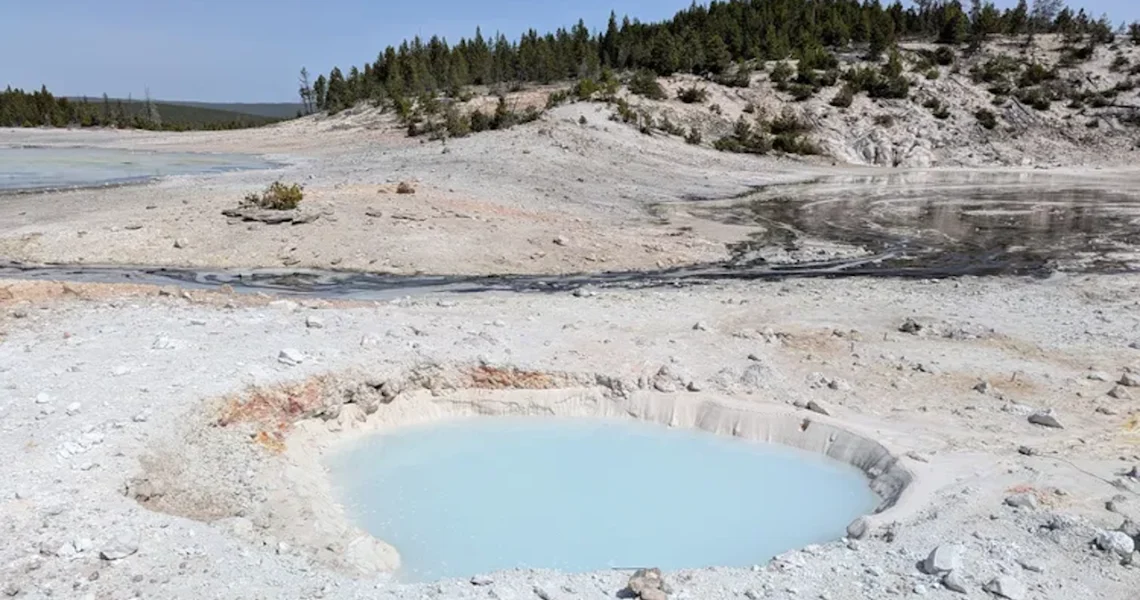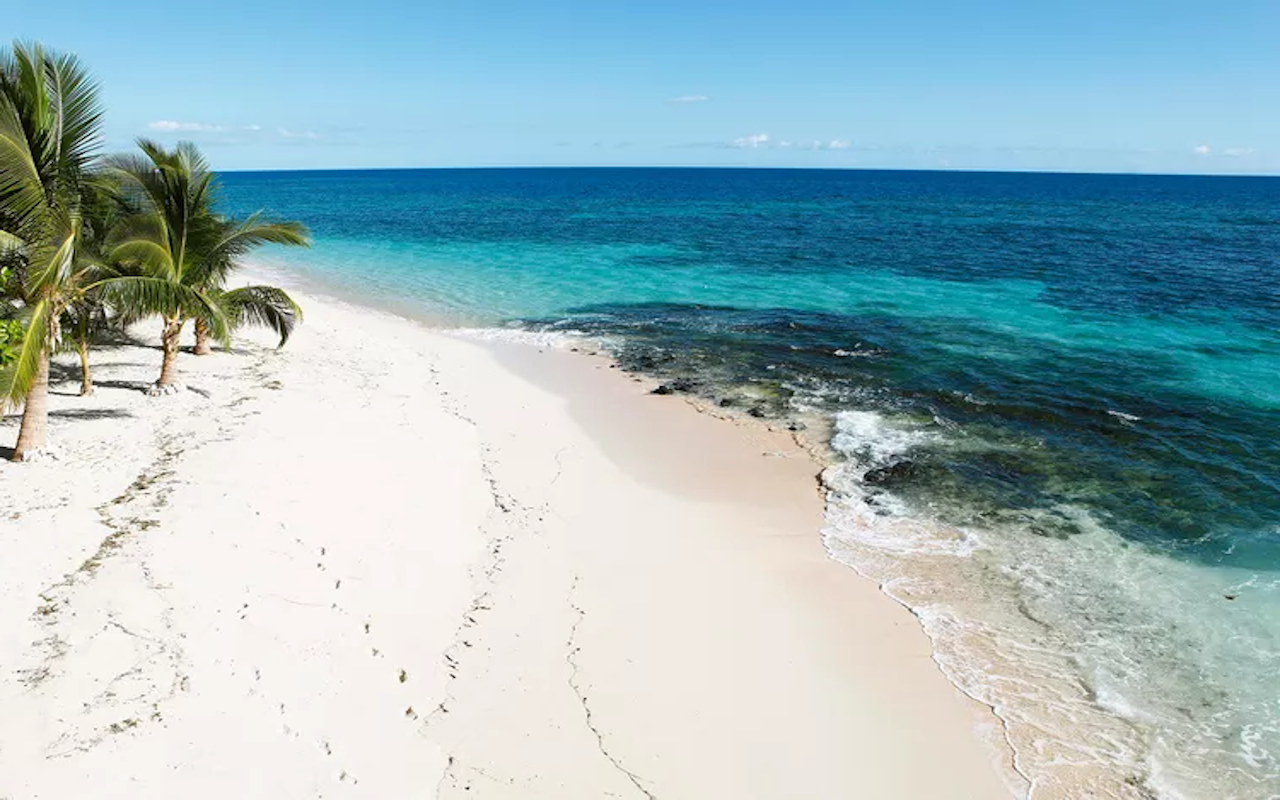Yellowstone’s New Blue Water Crater
The recent discovery of the new thermal pool in Yellowstone National Park is a testament to the park’s constantly shifting and active geological landscape.
Geologists from the U.S. Geological Survey (USGS), who continuously monitor the park’s dynamic systems, confirmed the presence of this stunning new feature. The crater itself is visually captivating, characterized by its striking pale blue water and surrounded by an ejecta blanket of rocks covered in light-gray sandy mud. This material was forcefully ejected from the ground during the explosion, creating a stark and immediate geological signature around the new pool.
Scientists have meticulously analyzed the formation of this feature, concluding that it likely developed through a series of multiple, smaller explosions rather than a single, massive event. The initial activity appears to have commenced on Christmas Day 2024, suggesting a festive but powerful start to its formation. Further geological “activity” continued into mid-to-late January and early February 2025, indicating a progressive development of the feature over several weeks.
The resulting pool now measures approximately 13 feet across, a significant size for a newly formed thermal feature. The water within the crater maintains a consistently steamy temperature, measured at a warm 109 degrees Fahrenheit, making it a distinct and active thermal pool.
The USGS emphasized the significance of this new feature within the broader context of Yellowstone’s hydrothermal systems. According to their statement, “The latest new thermal feature in Norris Geyser Basin—perhaps the most dynamic area in Yellowstone National Park—demonstrates the spectrum of ways in which hydrothermal features evolve.” This highlights that Norris Geyser Basin is renowned for its high level of geothermal activity and frequent changes, making it a prime location for such discoveries.
The USGS further elaborated on the varying pace of these geological transformations: “Some form during brief and violent episodes of change. Others may take shape far more gradually, like the new feature… that seems to have begun taking shape on Christmas 2024.” This observation provides valuable insight into the diverse evolutionary processes of Yellowstone’s thermal wonders.
High-resolution satellite imagery has played a crucial role in tracing the development of this new thermal pool. These images provided a chronological visual record, showing the initial signs of disturbance beginning in December 2024. By early January 2025, the area had developed into a small depression, indicating initial ground subsidence or minor explosions. The imagery then clearly revealed the feature as fully-formed by February 13, 2025, confirming a relatively rapid and observable geological transformation.
The USGS report further clarified the surrounding landscape, stating, “The rocks and white material (silica mud) surrounding the pool were probably ejected as the feature formed.” This ejected material is typical of hydrothermal explosions, providing direct evidence of the forceful nature of its creation. The ongoing monitoring through satellite technology and on-site geological surveys allows scientists to track these dynamic changes in real-time, enhancing our understanding of Yellowstone’s subterranean processes.
Hydrothermal Explosions: A Force of Nature in Yellowstone
Hydrothermal explosions are powerful and sometimes sudden geological events that occur when superheated water, trapped beneath the Earth’s surface, flashes to steam. This rapid expansion of steam creates immense pressure, leading to an explosion that can eject large quantities of water, steam, mud, and rocks. These events are a natural and integral part of Yellowstone’s geothermal activity.
The USGS notes that hydrothermal explosions are “somewhat common” throughout Yellowstone National Park. This means they are not daily occurrences but are a recognized part of the park’s dynamic geological processes. Their frequency and potential impact are precisely why the park maintains extensive monitoring systems and implements safety protocols for visitors. These explosions are distinct from volcanic eruptions, as they do not involve magma directly. Instead, they are driven by the interaction of groundwater with hot rock within the hydrothermal system.
A recent example illustrating the impact of these explosions is the Biscuit Basin trailhead. This popular area, located near the world-famous Old Faithful geyser, has been closed since an explosion occurred there in July 2024. The closure highlights that even smaller explosions can necessitate prolonged closures for safety assessments, cleanup, and to ensure the stability of the affected area. Such incidents serve as a practical reminder of the potential hazards associated with visiting active geothermal regions.
While the most recent hydrothermal explosion resulted in the creation of a beautiful new natural wonder, it’s critical to remember that in some cases, these explosions can be deadly. A sobering historical example is an explosion that occurred in El Salvador in 1990. This event tragically resulted in more than 20 combined deaths and injuries, according to a report from the Yellowstone Volcano Observatory. This international incident underscores the destructive potential of these phenomena, even if such severe outcomes are rare in Yellowstone’s monitored environment.
The size of hydrothermal explosion craters can vary significantly, ranging from just a few feet to hundreds of feet in diameter. The new feature in Yellowstone, at 13 feet across, is relatively small. However, much larger and more powerful explosions have occurred in the park’s geological past, shaping significant portions of its landscape. For instance, the renowned Mammoth Hot Springs terraces are partially formed by the ongoing deposition of travertine, but the broader landscape of certain thermal areas often bears the scars of ancient, powerful hydrothermal explosions.
These geological events are a crucial aspect of Yellowstone’s unique character. They demonstrate that the park is not static but a constantly evolving landscape, shaped by the immense heat and pressure originating deep within the Earth. For visitors, understanding the nature of these explosions helps foster a deeper appreciation for the park’s raw power and the importance of respecting its natural hazards by staying on marked trails and designated boardwalks. The continuous scientific monitoring by the USGS and the National Park Service plays a vital role in ensuring visitor safety amidst this geological dynamism.
Yellowstone’s Enduring Appeal and Visitor Experience
Yellowstone National Park consistently ranks among the most visited national parks in the United States, drawing millions of visitors annually with its iconic geysers, abundant wildlife, and stunning geothermal features. The park’s enduring appeal is a testament to its unique blend of natural beauty and geological wonders.
In 2024, Yellowstone welcomed an impressive 4.74 million people, according to data released by the National Park Service. This figure represents a significant increase, showing a 44% rise compared to the total number of visitors in 2022. This substantial growth underscores the park’s increasing popularity and its magnetic draw for domestic and international tourists alike. The continuous discovery of new natural wonders, like the recently formed blue water crater, only adds to the allure, providing fresh reasons for repeat visits and new explorations.
For prospective travelers, there isn’t a single “best time” to visit Yellowstone, as each season offers a distinct and unforgettable experience. The park’s diverse climate and varied landscape mean that its attractions transform throughout the year.
Visiting in the Warmer Months (Mid-April to End of October)
The warmer months, typically spanning from mid-April to the end of October, constitute the peak visitation period for Yellowstone. During this time, travelers will discover the park at its most accessible and vibrant:
- Amazing Camping and Hiking: With snow melted and trails clear, these months are ideal for outdoor enthusiasts. The park offers thousands of miles of hiking trails, ranging from easy strolls to challenging backcountry excursions, leading to waterfalls, wildlife viewing spots, and hidden thermal features. Numerous campgrounds are open, providing immersive outdoor experiences.
- Most Roads Open: Crucially, the majority of Yellowstone’s extensive road network is open during this period, allowing visitors to access key attractions like Old Faithful, Grand Prismatic Spring, Yellowstone Lake, and Canyon Village with ease. This connectivity makes self-guided tours and comprehensive exploration highly feasible.
- Wildlife Viewing: Wildlife is abundant and active. Bison often graze near roadways, elk are commonly seen, and opportunities to spot bears, wolves, and other creatures are higher.
- Visitor Services: All visitor centers, lodging, and dining facilities are typically fully operational, offering a complete range of services.
Exploring the Park in Winter
For travelers seeking a unique and quieter Yellowstone experience, heading to the park in the winter months (typically November through April) offers a vastly different, but equally rewarding, adventure:
- Fewer Crowds: A significant advantage of winter visits is the drastic reduction in crowds. The park transforms into a serene, snow-covered wonderland, providing a more intimate and solitary experience with nature.
- Plenty of Snowy Adventures: Winter unveils a new set of recreational opportunities. Travelers can traverse the park on skis, enjoy peaceful journeys on snowshoes, or experience the thrill of navigating designated routes by snowmobile. These activities allow access to unique winter landscapes and wildlife viewing often not possible in other seasons.
- Geothermal Features in Contrast: The steaming hot springs, geysers, and fumaroles present a dramatic contrast against the white snow and crisp air, creating incredibly picturesque scenes.
- Limited Access: It’s important to note that most roads are closed to private vehicles in winter, with access typically limited to snowmobiles and snowcoaches along groomed routes. This requires different planning but offers a specialized experience.
Regardless of the season, a visit to Yellowstone National Park promises an unforgettable encounter with one of the world’s most geologically active and biologically diverse environments. The recent discovery of the blue water crater simply adds another compelling reason to explore this magnificent natural wonder.






